BY GLENN KENNY
Photographed by Steve Pyle
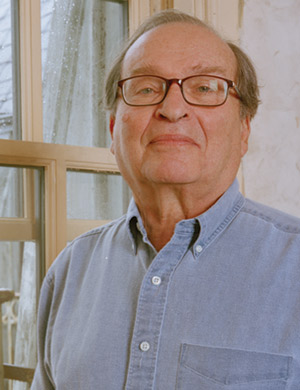 “I thought I’d be at work by now.” It’s a mid-August afternoon in New York and Sidney Lumet is talking about his next film. He’s not behind the camera for what most directors would consider the best of reasons. His latest picture, Before the Devil Knows You’re Dead, is garnering a huge amount of enthusiastic interest, requiring his presence on the fall film festival circuit. He’s glad for the reception, but also chomping at the bit.
“I thought I’d be at work by now.” It’s a mid-August afternoon in New York and Sidney Lumet is talking about his next film. He’s not behind the camera for what most directors would consider the best of reasons. His latest picture, Before the Devil Knows You’re Dead, is garnering a huge amount of enthusiastic interest, requiring his presence on the fall film festival circuit. He’s glad for the reception, but also chomping at the bit.
Lumet turned 83 in June, but the director of diverse modern classics such as The Pawnbroker, Serpico, Dog Day Afternoon, Network, Murder on the Orient Express and Prince of the City shows no inclination to slow down. Indeed, his embrace of new moviemaking technologies seems to have brought with it an increased energy.
Born in Philadelphia in 1924, son of Yiddish theater star Baruch Lumet and dancer Eugenia Wermus, Lumet acted and directed in the New York theater before making his way into television, adapting popular plays including Don Quixote and The Philadelphia Story and directing episodes of the neo-news program You Are There. He made his feature film debut in 1957 with 12 Angry Men, featuring a powerful ensemble led by Henry Fonda. It was the first of his formidable casts that would later include Hoffman (Dustin and Philip Seymour), Newman, Connery, Pacino, Holden, Dunaway, and Fonda again—this time Jane. For his talent with actors and skill in telling a story, he was presented the DGA’s Lifetime Achievement Award in 1993.
Unlike his fellow New York chronicler Martin Scorsese, Lumet’s personal signature isn’t easily pinned down. He insists his ever-proficient style is subservient to the material, and that’s what comprises his “statement.” In the historic Ansonia building on the Upper West Side where he lives and works, the voluble Lumet discussed the varied approaches that have yielded his many indelible urban tales.
GLENN KENNY: The course of your career spans six decades now…
SIDNEY LUMET: Jesus!
Q: ...and the tools of both television and film have changed a lot in that time. How has that affected your work over the years, starting in television and now in an era of digital shooting and editing?
A: The interesting thing is that it’s almost coming full circle. I’ve been working in high-def now for several years. And one of the pleasures of it, aside from being able to use less light and so on, is that I’m able to go back to multi-camera techniques, which is of course something that comes completely from television in the era I started to work in it. When I did Find Me Guilty [in 2005], we’d be knocking off eight pages a day. For the courtroom scenes—well, courtroom scenes were made for what we used to do on TV; they’re static, someone’s sitting in one chair and someone else is sitting or standing, asking questions. And by covering it with two or three cameras, you can get an awful lot done. The whole multi-camera technique is something that I think has a great deal to offer, particularly in terms of performance, which always interests me enormously. So that the whole thing has come back around to something I began with, from a technical point of view, is very, very exciting. I think high-def is going to have so much to offer everybody. God, to finally get rid of those agonizing fights about color control with those guys from Technicolor who always had their own ideas, not to mention print costs. And it’s only a question of when the projectors will come into the theaters; then we’ll be able to put the film on one disc at 1545 Broadway and it’ll go into 4,000 theaters.
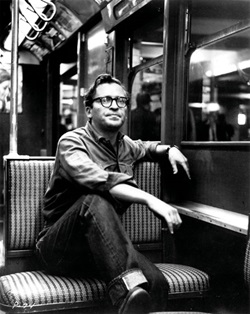 Lumet on an old subway car during filming of
Lumet on an old subway car during filming of
The Pawnbroker. (Credit: AMPAS)
Q: So you’re obviously pro-digital. There are a lot of filmmakers who still worry about the quality of the image.
A: It’s that perennial fear of something new. You can get not only great image quality—although I must say I’d like to see the pixels increased, but that’s a very simple adjustment and, even now, it’s certainly passable. But there are certain things that are already so superior to film. Your focal depth—just no comparison. And the additional advantages: For example, a movie like Dog Day Afternoon, where your first obligation is to put across the idea that, ‘Hey folks, this really happened.’ This picture is nothing if it’s an invented picture. It’s only interesting, and true, because of the reality of it. Well, we were killing ourselves trying to get film to look real. Because film color is not real. And we accept it because we have to and because we’re used to it. The sky is not the blue that you see on film. And the green grass is not the green you see on film. I remember once in London stumbling across Antonioni shooting a picture [Blowup] with Carlo Di Palma and they were painting the grass green. And I said to Antonioni, ‘Did you not like the color?’ He said, ‘No, I just want it to look like real green.’
Q: Did you have artistic tendencies as a kid?
A: I had a chance as a kid to get a lead in a play and it was a success, so that put me in this category of kids who do something different. Then I wanted to continue as an actor, but I was not accepted to any acting schools. So I really struggled a lot. Then I had a chance to get in to the film school. But I also went to art school, I did my baccalaureate in art. Painting, drawing, sculpture, graphics, all that. That gave me a good basis for what I wanted to do later, which is film directing.
Q: As you got older, what films influenced you in a more serious way?
A: The first film that had a great impact on me and I feel I'm always trying to copy is Carol Reed's Odd Man Out. The whole atmosphere, strangely enough, resembles very much my childhood city of Krakow, with the change of seasons that can happen in one day. That atmosphere seduced me, and then I thought of the acting, of the photography. And then I realized much later that there was something
Q: And you can’t get that on film?
A: When you need something to look real, like Dog Day, you’re just not going to ever get it on film, as much as we tried, because it’s a chemical process. We used no artificial light; we augmented light. And the night scenes, we just added more light to bounce off. The reason we chose that building was because it was a white front; it could give us enough bounced light so that we could photograph the people across the street. And with high-def you can get just exactly what your eye sees. You can get it because it’s an all-electromagnetic process, which is what light is, and that’s what high-def is recorded as and what it is projected as.
Q:What about cinematographers, how do they feel about it?
A: It was interesting how some lighting cameramen first reacted to high-def. I remember the first demo reel I saw of high-def and it looked like 1940s Technicolor—because they hired film cameramen and the object was, hey, make it look like film. Well, don’t make it look like film. Let it look like what it is. And because you can get any degree of stylization you want to. I remember when I did, for my sins, a live TV show of Hans Brinker and the Silver Skates with Tab Hunter and pretty, perky Peggy King. And we did it out at NBC’s studios in Brooklyn. There was a sequence in which he’s wandering around looking for his father all day, into the night. And on air, live, we first withdrew the yellow circuit, faded it down, and faded down the red circuits, and all we were left with was the blue circuit and it was monochromatic blue. Not only beautiful, but you really got a feeling of a whole day passing. Now I don’t have to tell you what that would have taken to try to do in a lab, and what it would have cost. And there we were, doing it live.
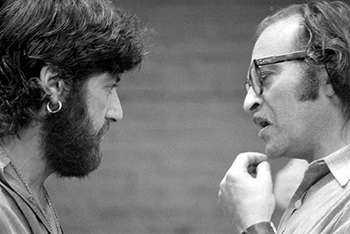 UNDERCOVER: Lumet with Al Pacino on the set of Serpico (1973).
UNDERCOVER: Lumet with Al Pacino on the set of Serpico (1973).
(Photo Credit: Photofest/Paramount Pictures)
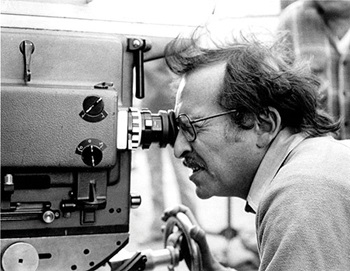 DIRECTOR'S VISION: Lumet looks at the world he created in Dog
DIRECTOR'S VISION: Lumet looks at the world he created in Dog
Day Afternoon (1975). Photo Credit: AMPAS/Warner Bros.)
Q: Do you feel similarly about editing digitally on an AVID?
A: It’s wonderful. I miss the old thing, of course, because I loved physically handling film myself. And when you’ve done as many pictures as I have, you do mark off your own ends. I love the Moviola, it’s one of the most perfectly beautiful machines that exists. Boy, if beauty is form following function, the Moviola was the perfect example of it. Not an extra thing on it. A wonderful machine, and I used to love physically handling the film. And I miss that. But that’s just a little personal pleasure that I don’t have anymore.
Q: Speaking of high-def, some scenes in your new film Before the Devil Knows You’re Dead are more sexually frank than anything you’ve done before. Did shooting in high-def help you get greater intimacy for those scenes?
A: One of the things is, again, the multi-camera technique. When Marisa [Tomei] has a scene in which she’s got on a simple pair of panties, which barely cover anything, and Ethan [Hawke] is naked, I had two cameras. And bang, one take is the scene. No reverses to do. No second shots to do. We did about three or four takes of the actual scene, but there were no other setups. One setup with two cameras. It’s invaluable to the intensity of the scene. Again, the subject matter was helpful in the sense that it staged itself very simply. But the scenes between Ethan and Philip Seymour Hoffman in the bar, confronting each other after a robbery scheme has gone wrong, which also had this incredibly high level of intensity between them, were two setups each: one tighter shot, one cross shot. So that neither actor had to read lines for the other person’s side in a reverse shot. And because the actors know they’re not in a situation where they’re going to have to do their lines again for the other guy’s setup, they can go for broke; there’s not going to be a wasted take.
Q: New York has supposedly ‘cleaned up’ a lot since the pictures that established you as a quintessential New York director: Serpico, Prince of the City, Dog Day Afternoon. But in Devil you reveal the still-extant seamy side of the city in some astonishing scenes of a high-end heroin parlor.
A: I wanted two things out of those scenes. I wanted ice. And number two, I felt it was, aside from the dope itself, the kind of place that Hoffman’s character would aspire to. His fondest wish. It wasn’t only dope that he got out of there, it was his future. And finally, I wanted the setting and feel to be very modern. It doesn’t belong to old New York.
Q: Like Devil, your recent films have been financed independently and then distributed through smaller newer distributors. The kind of pictures you make—adult dramas—are not really supported by the studios anymore. When did the shift start happening for you and how have you handled it?
A: Well, in a funny way, it’s always been happening. I mean, The Pawnbroker (1964) was financed by Ely Landau. And if I remember correctly, our first checks were signed by his wife. He didn’t even have his corporate account set up. So, too, was Long Day’s Journey into Night (1962). It’s always been nice to have those odd financing sources around, if you could get to them. I remember A View from the Bridge (1961) I did for a French producer by the name of Paul Graetz. And he put up the money himself, which stunned me. The thing is, that because financiers like that cannot compete with studios in terms of the hot material, or the quote-unquote commercial material, they tend to be more adventurous.
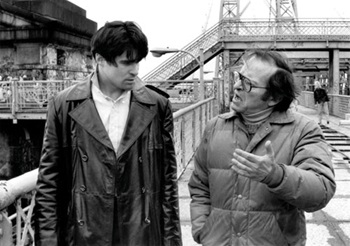 Lumet directs Treat Williams in Prince of the City (1981). (Credit: AMPAS)
Lumet directs Treat Williams in Prince of the City (1981). (Credit: AMPAS)
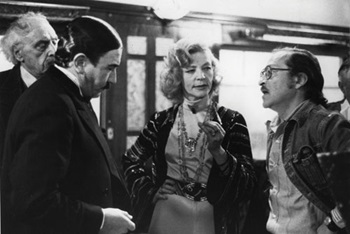 Lumet with actors Albert Finney and Lauren Bacall on the set
Lumet with actors Albert Finney and Lauren Bacall on the set
of Murder on the Orient Express (1974). (Credit: Photofest)
Q: The Hill was your first film with Sean Connery, whom you’ve directed five times—in The Anderson Tapes, The Offence, Orient Express and Family Business. Now, he is not known as someone who always forges a bond with a director.
A: No, he forms very few bonds, despite having been James Bond! I think one of the reasons we immediately got close was the first thing he felt from me was enormous respect for him as an actor. When you look at the Bond characterization, everybody says, ‘Oh, well he’s just charming.’ Well shit, that’s like saying Cary Grant was just charming. There is more acting skill in playing that kind of character. What he’s doing, stylistically, is playing high comedy. And that is extremely difficult to do, which is why there are so few of those actors, so few Cary Grants and Sean Connerys. But it’s acting, don’t kid yourself. And right away on The Hill, the very fact that I cast him in it meant something. And he was so thrilled to be taken that seriously for that kind of a drama. And when he got to produce a picture of his own, The Offence, a story he picked out, I was thrilled to be asked by him to direct.
Q: I want to talk about the period in the early to mid-’70s when, not just the quality, but the diversity of the projects you made is pretty remarkable. That includes Serpico, which is an iconic role for Al Pacino, another actor with whom you built a special rapport. How did you two approach each other initially?
A: In a sense, you start with suspicion. There had been another director working on Serpico who wasn’t working out. And we talked, and Al was very careful. It wasn’t a very long meeting and Marty [Bregman, his manager] called me a couple of hours later and said, ‘Come to work.’ Waldo Salt’s script was superb. However, it was 240 pages. But whoever had done the rewrite had somehow gotten it down to 130. We could do nothing about the start date because Al had to be available for Godfather II. But Al did something quite brilliant. When we started rehearsal he knew Waldo’s original script better than I did because he’d been with it for a long time. So he came in with Waldo’s dialogue and he’d say, ‘Sidney, can we read this?’ And we’d read it and it was often better. And in rehearsal we put together a new structure with Waldo’s dialogue. I think that Al saw that I was open to him and not playing turf games and things like that. That, and the first day of shooting, spun us close together because he had never shot that much on the first day—we had three different locations in three different sections of Manhattan. He didn’t know where he was at the end of the first day except that he knew that somehow or other six pages had been done.
Q: Looking at those pictures from that period, you go from Serpico to Lovin’ Molly, which is a different kind of intimate piece, then to a huge multi-star production, Murder on the Orient Express. Then to something far grittier, more realistic, Dog Day Afternoon. And then the larger-than-life satire of Network. How do you get your head around the particularities of each project?
A: Well first of all, from that list, wasn’t I lucky? Let’s start with that. Because I come from the theater, I always feel my obligation is to the piece, not to what I want to say. Rather, what I want to say is clear by simply the fact that I chose that piece. And the ‘what’ of what you’re saying is going to determine the ‘how.’ So that, as I said before, when you’re talking about something like Dog Day, where the obligation is, ‘Hey folks, this is really happening,’ you have to be very straight—no fake climaxes, nobody’s going to yell at anybody unless it’s a yelling situation, you’re not going to dramatize anything. You’re going to record it, essentially. And try to keep it, as best you can, the simplest, most honest, realistic statement that moment demands.
Q: And then what attracted you to do something like Murder on the Orient Express?
A: The basic appeal of Murder on the Orient Express, aside from how delicious the story is, it’s nostalgic. I mean the train, nobody’s been on that fucking train, but everybody thinks they’ve been on it. And that’s because we just made it the most glamorous thing we could. So as soon as I’m dealing with the material, the shifts in style are not that strange. They don’t take that much effort. If I say yes to a script, I may not know how to do it yet, but the idea that it’s got to be done in a very specific way is immediately apparent to me. On Prince of the City, I didn’t know till quite late, till almost a week before we started. I really didn’t know how I was going to do that movie. And that had to do with the complexity of the story, and had to do with the fact that I didn’t know how I felt about the leading character. I didn’t know whether I loved him or hated him. The way I was brought up, a rat is a rat. But then there’s the idea that he was actually somebody heroic. So these things are all—it’s all tied to the material.
Q: Prince of the City was your second collaboration with screenwriter Jay Presson Allen, and the first time you took a screenwriting credit. In a 1960 interview with Peter Bogdanovich you said emphatically, ‘I’m not a writer.’ What changed?
A: Well, I still am not a writer. There are certain pictures that I’ve either co-written or done the entire script where I know the sound. They’re usually cop pictures. And they’re usually New York pictures. I know the people and I know the sound. And it’s just a hell of a lot quicker and easier for me to do it. But that’s very different than the writing talent that’s required, let’s say, for a script like Murder on the Orient Express. That takes a writer. And I would never kid myself that I’m that level.
Q: You’ve talked about the irony of how some critics referred to Prince of the City as ‘realistic,’ whereas you very deliberately made it in a more expressive style—in terms of the lenses you used, forced perspectives, making certain objects prominent in a frame. It’s almost as if you did your job too well, because the viewer does get caught up in the emotional reality of the story.
A: Prince of the City is a highly stylized movie. And one of the reasons I’m glad that it’s not discussed from a stylistic point of view is that, to me, it’s bad style if people spot it. However, I’m not letting any critics off the hook. You’re a critic because you should be able to spot it. You know, you’re not a critic just for your opinion. My elevator man has got an opinion. Theoretically, you know movies enough technically so that you can get some sense of what lenses are being used, so that you can recognize a color palette. The color palette in The Verdict is wonderful and so carefully worked out. You know the color blue appears only once in that movie? I couldn’t get the sky out of the shot. And I looked for a way to change the lens, but I needed that lens for another reason. But that kind of control in a movie is what my work is about.
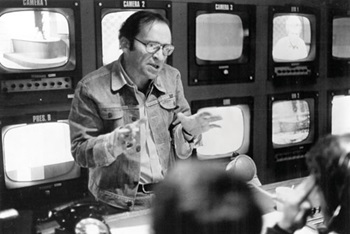 Lumet setting the tone on his still-relevant TV news satire Network (1976).
Lumet setting the tone on his still-relevant TV news satire Network (1976).
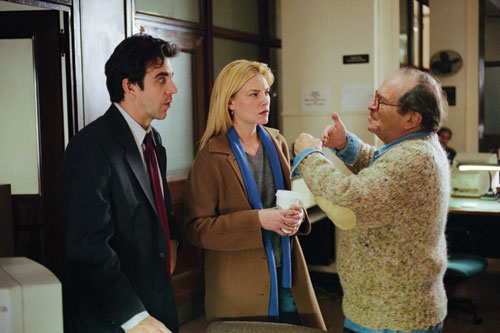 Lumet coaching Joseph Lyle Taylor and Paula Devicq on his TV series
Lumet coaching Joseph Lyle Taylor and Paula Devicq on his TV series
100 Centre Street. (Credit: Mark Peterson/Corbis)
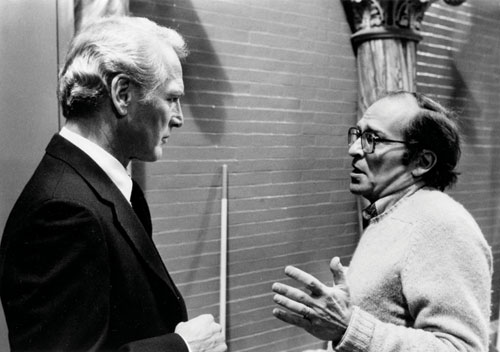 Lumet directs Paul Newman on The Verdict (1982). (Credit: AMPAS)
Lumet directs Paul Newman on The Verdict (1982). (Credit: AMPAS)
Q: A major difference is the parents in Running on Empty, fugitive ’60s radicals, are present.
A: Right. And it was also, in a way, a much simpler, more sentimental story than Daniel. The title character in Daniel is a tough one in himself. And even the sister, institutionalized and all, is not an easy character. Nor is either of the parents. In Running on Empty, everybody is much more accessible. The boy’s more terrific and noble and the parents are victims, labeled as victims early on, right in the first scene. So, in a way, it was the same theme in a simpler framework. And I’m a stubborn bastard. When that didn’t work, I actually did a comedy about the theme, or tried to do a comedy about it [Family Business], which wasn’t funny.
Q: One comedy you made that’s indeed very funny was 1980’s Just Tell Me What You Want. It’s a movie that gets The Russian Tea Room side of the city just as accurately as Dog Day Afternoon got working-class Brooklyn.
A: I don’t know why that picture wasn’t given wonderful reviews, and I don’t know why it didn’t do well. I found it hilarious. I find Alan King just superb. And Ali MacGraw, heaven—gorgeous, funny, tough. You know, people always underestimate each other. Jay [Presson Allen] wanted her from the get-go and I said, ‘I’m not sure she can act.’ And so Ali came down, and we met, and she made me an offer I couldn’t refuse. She said, ‘Sidney, you know what? I can’t act. I’ve never studied; I have no technique whatsoever. And I’m not going to just be able to depend on inspiration for this role.’ And she said, ‘Let’s do something, if you’re willing. Why don’t you give me acting lessons for two weeks. And at the end of that time if you don’t think I can do it, I’ll have had a nice time in New York, and I’m a very pleasant person to be around, so you will have had a nice time.’ How do you turn that down? And within five days I was convinced she could do it. I didn’t even do the second week’s work.
Q: And you can’t get that on film?
A: When you need something to look real, like Dog Day, you’re just not going to ever get it on film, as much as we tried, because it’s a chemical process. We used no artificial light; we augmented light. And the night scenes, we just added more light to bounce off. The reason we chose that building was because it was a white front; it could give us enough bounced light so that we could photograph the people across the street. And with high-def you can get just exactly what your eye sees. You can get it because it’s an all-electromagnetic process, which is what light is, and that’s what high-def is recorded as and what it is projected as.
Q: Sometimes things don’t work out as well. In your book you memorably refer to Bye Bye Braverman as a picture that was supposed to be a soufflé and came out a pancake. When you know a film is not going to be what you envisioned or hoped, how can you save yourself and/or the picture?
A: The first thing you have to realize is that you may not be able to save yourself. And also with the realization, if you’ve got any sort of common sense about you, that the really good pictures are accidents. I’m not being falsely modest. The reason the accident has happened to me a number of times and will never happen to other people—the only thing that’s going on is how highly prepared the groundwork is to make the accident possible. I think the biggest danger comes when you try to rationalize the failures into successes: ‘Oh, what I really meant there, they never got it.’ But sometimes they don’t get it because you didn’t get it.
Q: Did this happen to you on other films?
A: There are any number of times that I didn’t get it. With Braverman, I was just not that ready to deal with that level of comedy. I wasn’t that firm about it, I wasn’t that secure about it. I wasn’t that knowledgeable about it. And also, not part of my talent. You don’t know what your talent is until you try it. You can learn a lot of technique that makes something work, that makes comedy work. But that’s different than having an intrinsic talent for it. I’m perfectly all right with naturalistic comedy. When Jack Warden has to sit around in 12 Angry Men and make jokes, no problem, because it’s just a realistic moment. There’s no stylistic departure from realism. As soon as it requires a departure, that’s trouble. And Braverman was just too soon. And I’ve said this before, one of the reasons I did Murder on the Orient Express was because it was necessary for that picture to be gay in spirit, and you’ve never seen anybody work so hard for that lightness, because I had to learn a whole new way of doing something. And thank God I did, because I don’t think Network would have been as good as it was if it hadn’t been for Murder on the Orient Express. This also has to do with reasons that one chooses to do material.
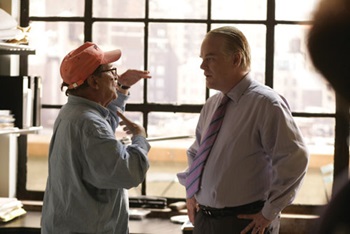 MEAN STREETS: Lumet looks for intensity from Philip Seymour
MEAN STREETS: Lumet looks for intensity from Philip Seymour
Hoffman in his latest film, Before the Devil Knows You're Dead.
(Photo Credit: Will Hart)
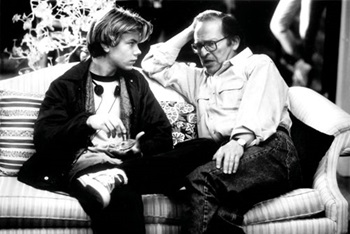 Lumet gives instructions to actor River Phoenix on Running
Lumet gives instructions to actor River Phoenix on Running
on Empty (1998). (Photo Credit: AMPAS/Warner Bros.)
Q: You want to stretch.
A: You want to stretch—or you want to buy a house. They’re all legitimate. As long as you don’t try to kid yourself. When I did a picture for David Merrick [Child’s Play, 1972] it was a very simple reason. I had just seen a great house at Lexington Avenue and 91st Street, and my wife was pregnant and I needed $35,000 to put down for it. And I was thrilled that a picture came up that would give me the money for it. But I didn’t try to tell myself that it was going to be a major work of art.
Q: One stretch people never expected you to make was the musical The Wiz.
A: My love of New York had a lot to do with it. I had an idea which was that one of the best ways of doing a fantasy was to use reality. And I wanted to do a picture in which New York City itself became unreal. So it seemed to me that a piece like The Wiz had been sent to answer my prayers. But again, I ran into the problem of not knowing enough in a particular field. I didn’t know enough technically. I had visual effects artist Albert Whitlock, who was the greatest matte artist in those days—this is before CGI. And if he told me he needed something, I said OK. If he told me something was impossible, it became impossible. Because I didn’t know better. That doesn’t exist for me on any other level of movies. If the soundman is sitting there, and tells me I can’t record in a certain location, I know if it can be done and how it can. I know what mike he can use, what level. I couldn’t respond that way to Albert. And so what happened was that as we went around looking at locations, because of Albert and [production designer] Tony Walton telling me what I couldn’t do with them, more and more of the shooting got relegated to the studio. So I was losing the whole point of why I wanted to make it in the first place. Because I couldn’t tell them how it could be done. So it was just sheer chutzpah on my part to bite that off at that time.
Q: In 2001 you returned to television as executive producer of the series 100 Centre Street, directing some episodes as well. How did that come about?
A: The main reason I wanted to do it was because I had seen a demo that somebody had made with a high-def camera. The Yankees won the pennant that year, there was a shot of some of them coming down Broadway. And the camera was practically at street level shooting up, and the car was coming right toward the camera. Joe Torre was in the car, and there was a big white, hot building behind him, and there were four cops, two in front and two in the back, walking alongside the car. This was all being carried in focus without any tearing as would have happened with a live television camera, and getting amazing accuracy in differences of skin tone. I said, ‘I’ve got to look into this.’ And I had had this idea for a television series, and had never done anything with it, and I went to see them at A&E and I said, ‘I want to be able to do it in high-def, multi-camera technique. And if you’re going to want to do it on film, I’m not interested.’ And they said, ‘No, no, that’s fine.’ And I wrote a script and they were so enthusiastic and they said, ‘Let’s go.’ They didn’t even want a pilot. And so we went right to work. That’s how it happened. Unfortunately, we came on at the end of September and in November, they shifted our playing time. It doomed us. But I would love to try something like that again.
Q: You’ve made something like 50 films and hours and hours of television, but you don’t seem to be slowing down. What’s next for you?
A: It’s a script I wrote and I’ve had a very long time, called Getting Out. It’s practically financed. I felt I’d be at work on it by now and I’m still hopeful but it’s getting kind of tight for this year because Devil is getting some good attention. We’re getting into a lot of festivals, which is good because it’ll launch the picture correctly. But all my September is gone now. So I don’t know if I’m going to be able to get going this year, because we should have gotten started already.
Q: I was going to ask you if moviemaking still excites you as much as it did at the beginning, but I can tell from talking to you that it still does.
A: Oh, yeah. Absolutely.